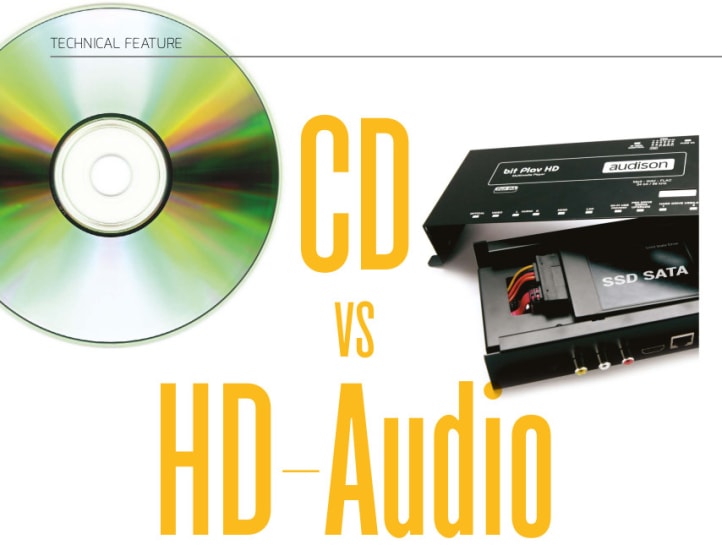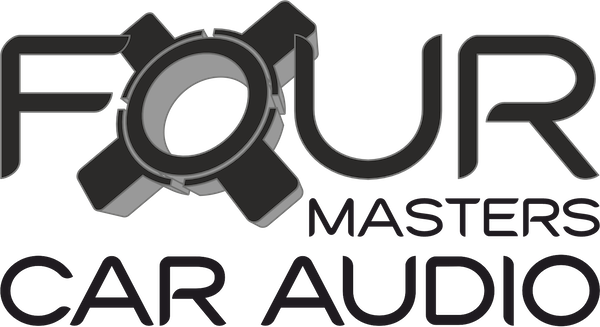
CD vs. HD Audio
16-bit vs. 24-bit Word-depth Audio And Other Formats!
This topic is probably one of the most difficult to boil down for the layperson, but we never like to shy away from a challenge!
Digital audio is a very complex and controversial business due to the apparent need to parameterise what is considered by many to be as psychological a phenomenon as it is physics-based. An example of the battle digital audio pioneers still have on their hands is the fact that continued blind AB testing of “golden-eared” luminaries still points to the possibility that although the limit of human hearing in terms of frequency response is scientifically proven to be around 20kHz, analogue systems such as vinyl (which will produce in some cases up to 50kHz) sound better.
It is necessary to put such unknowns to one side however, and have a pragmatic explanation as to why increasing the number of bits from 16 to 24 in a digital system is or could be desirable. However, if the science is not for you, then feel free to skip to my conclusion at the end of the piece.
‘Digital anything’ is all about the maths. Digital signal manipulation is especially so, and this can be quite handy when comparing parameters. As you will probably know, music is not all about frequency response (lowest and highest notes that can be heard) but also about dynamic range (loudest and quietest sounds) sometimes expressed as a ratio of signal to noise. In hi-fi, dynamic range can arguably be said to be more important than frequency response. Why? As people become older, their ears work less well and the fall-off in perceived frequency response particularly at the top-end is where the biggest change happens. It is not that high frequencies disappear, but they attenuate as our hearing equipment ages, causing our brains to receive reduced information at certain high frequencies. This does not lead to a desire for more high frequencies amongst the older population by the way. In fact and bizarrely so, the older listener tends to favour a smoother, more rounded top-end to the fledgling young listener in my experience and I don’t now why, but would be thrilled to hear from anyone who does!
Bit Depth
When CD was developed, the declared aim according to its chief protagonists, was to satisfy the most discerning listener while presenting the most convenient and robust music-carrying medium to ever grace humankind. For technological convenience as much as anything, a16-bit word depth architecture was decided upon.
16-bit digital technology was already quite well developed and cost effective components were available off-the-shelf. Digital audio works by sampling audio signals and chopping them into very small pieces which can be described in a mathematical way using “words” made up of just the digits “1” and “0”. 16-bit word-depth allows each sample to convey over 65,000 slices of amplitude information, which theoretically allows a 96dB dynamic range to be achieved. This was felt to be plenty as the mainstream consumer had previously been used to cassette tape, which could only achieve around 60dB at best. However, the human ear is capable of discerning a dynamic range of up to 127dB and a piano for instance can itself produce 104dB or more! In the exacting recording studio environment, 96 dB was never going to be enough. The idea at studio level is to seek quality without compromise in the signal path. Digital audio developers were hard at work attempting to perfect the technology to not merely match what had gone before but to beat it by some distance. 22 then 24-bit overtook 20-bit effects processors and drum machines and 32-bit is now common in equipment within recording studios. So, how much difference does adding an extra couple of bits make to dynamic range? The answer to this is quite a bit (excuse the pun). By the time we get to 24-bit, our 65,536 slices of amplitude information becomes 16,777,216, which is 256 times greater. Important point here: This does not mean your music will sound 256 times better - far from it in fact - but twice as good is a gargantuan improvement in audio terms!
Sampling Frequency
So, just as we are getting comfortable with the idea of bit word-depth, we have to add in another parameter - sampling frequency. This is the amount of times a piece of audio can be sampled per second or how many component parts we can split the frequency of a sound into. With CD a sampling frequency twice the value of the maximum audible frequency was chosen, however you will have come across different sampling rates when ripping CD’s and especially when converting from WAV to MP3 for instance. I previously mentioned that although the limit of human hearing is 20kHz (ish), there is likely to be a psycho-acoustic recognition of information way above this figure. This is why in very simplistic terms, sampling frequencies of 96kHz tend to go hand-in-hand with 24-bit word-depth audio.
The scientific facts
Whether the above oversimplifies the science and maths of this topic or not, and notwithstanding the current limitations in digital to analogue conversion techniques and the use of “dither” in digital music encoding, the plain fact is that music encoded and conveyed in a 24-bit, 96 kHz architecture is better than audio converted by a 16-bit, 44.1kHz architecture. The major noticeable difference is increased dynamic range. This governs the life, ambience, timbre and positional information contained within a piece of music which consequently leads to improved instrument separation. This is why audiophile car audio company Audison has gone to extreme lengths to add a 24-bit, 96kHz source unit, bit Play HD, to its array of world-beating car audio products. You can read all about it and hear how we got on when we auditioned it elsewhere in this issue.
Should Everyone Invest In Equipment Capable Of Delivering High Definition Audio?
I cannot speak for everyone. I have ears that are accustomed to high-quality listening and despite my advancing years and the effect those have on my ability to hear the high notes, I am really enjoying high definition audio. I have never been a gadget geek or a fad-collector of shiny things for the sake of it. In fact I have invested comparatively little in my own passion for music. In the course of writing this magazine however, I have conducted detailed listening exercises both at home and in cars with varying results. What has become clear is that AB comparisons may not throw up huge and obvious differences. The effect is subtle but absolutely, definitely, undeniably perceivable even on rather modest audio systems. As I write this for instance, I am listening to a 24-bit, 96kHz version of Michael Jackson’s “Off The Wall” album that is playing from a laptop connected via its headphone output to a vintage NAD 3020 amplifier connected to a pair of JVC wood-cone book-shelf speakers. I am listening at a background level and I can hear every single huff, puff and hiccup the boy emitted during the making of the album and the percussion has a truly 3D quality about it. I can hear bells, cymbals, triangles and all manner of other sounds and they seem to be attacking me from all over the 12 X 8 foot room I am working in. I know that the CD of the same album would not sound so alive and many of the insanely clever beats, booms and tings that Quincy Jones put into the original recording would go unnoticed. Whether this is due to the science described here or due to some odd psycho-acoustic effect, I could not categorically say, but I am completely sold on this technology as a tangible improvement on CD listening. In the tiny confines of a car, the effect is much more dramatic. When you close your eyes and listen, the boundaries of the tin box you are in simply disappear altogether – Don’t try this whilst driving however!
Audison bit Play HD is available now from all FOUR MASTERS and FOUR resellers. Why not go and have a listen.
Top Five High Definition Audio Songs
Kiss From A Rose – Seal
I Can’t Help It – Michael Jackson
Steamroller Blues – James Taylor
Moby Dick – Led Zeppelin
Satellite Of Love– Lou Reed
Find out what our partner, The FOUR MASTER Network, can do to bring Hi-Fi quality to your car. Simply put some brief details into the form below.
Not ready for that yet? You can use the same form to book a demonstration at your home, place of work or with your local FOUR MASTER
